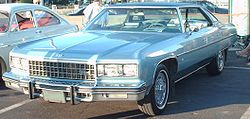- Downsize (automobile)
-
Downsizing in the automobile industry is the practice of redesigning a vehicle to retain the interior volume, and often the nameplate and styling of a larger car to a smaller, more efficient platform. General Motors was among the first to announce a downsize strategy for the whole company as a response to demand for smaller more efficient cars.[1] An alternative strategy was to simply rebadge or mildly restyle smaller vehicles, as nameplates such as the Ford LTD and Plymouth Fury were applied to smaller platforms.
Contents
Examples
General Motors
The first cars to be downsized were the 1977 full-size cars for Buick, Cadillac, Chevrolet, Oldsmobile, and Pontiac. Most models were left a foot shorter and averaging 750–800 lb (340–360 kg) lighter. This created a marketing problem, since the full-size cars had substantially less shoulder room than their predecessors, and were narrower and barely longer than GM's mid-size cars. This problem was solved by having sales advertisements mention any increases in headroom, legroom and trunk space while avoiding all mention of shoulder room. For the 1978 model year, the intermediate GM A platform was redesigned and downsized to near-compact dimensions. After the second gas crisis in 1979, the cars of the GM X platform were redesigned and replaced by front-wheel drive counterparts. By the end of the 1980s, nearly all cars produced by GM would be front-wheel drive. At the end of the 1996 model year, the B-platform was discontinued; the cars were shifted onto front-wheel drive platforms.
Size comparison between 76 and 77 Caprice
1976 Caprice 1977 Caprice Wheelbase 121.5 in (3,086 mm) 116.0 in (2,946 mm) Overall Length 222.9 in (5,662 mm) 212.1 in (5,387 mm) Width 79.5 in (2,019 mm) 75.5 in (1,918 mm) Height 53.7 in (1,364 mm) 55.3 in (1,405 mm) Front Headroom 38.9 in (988 mm) 39.0 in (991 mm) Front Legroom 42.5 in (1,080 mm) 42.2 in (1,072 mm) Front Hip Room 59.3 in (1,506 mm) 55.0 in (1,397 mm) Front Shoulder Room 63.8 in (1,621 mm) 61.1 in (1,552 mm) Rear Headroom 38.0 in (965 mm) 38.2 in (970 mm) Rear Legroom–ins. 38.8 in (986 mm) 39.5 in (1,003 mm) Rear Hip Room 59.7 in (1,516 mm) 55.7 in (1,415 mm) Rear Shoulder Room 63.8 in (1,621 mm) 61.1 in (1,552 mm) Luggage Capacity 18.9 cu ft (535 L) 20.9 cu ft (592 L) Chrysler
Unlike Ford or General Motors, Chrysler's full-size car sales did not rebound from the initial |1973 gas crisis. The 1974 models were the last full-size models Chrysler designed from the ground up, as the short lived 1979-81 R-bodies were stretched versions of the old mid-sized B-bodies. Instead Chrysler focused on updating its midsize and personal luxury car lines. By 1982, Chrysler's "full-size" cars were not even considered full size by EPA standards, and were built on the midsize M-platform which was almost identical to F-body, which had been considered a compact car as recently as 1976. For mid-size cars, Chrysler offered the K-car, a 6-passenger sedan that combined mid-sized interior room with compact exterior dimensions; its front-wheel drive layout was adopted in virtually all Chryslers into the 21st century. Chrysler also introduced the minivan as a family vehicle as a replacement for station wagons based on full-sized sedans; by 1992, Chrysler no longer made station wagons of any size.
Ford
Alongside Chrysler, Ford introduced its own downsized full-size car platform in 1979. Like GM's downsizing, the Ford and Mercury models of Panther platform were over 15 inches (380 mm) shorter and 800 pounds (360 kg) lighter; the Ford LTD was left lighter and shorter than the "intermediate" LTD II. However, Ford retained the same amount of interior room from the 1978 model. In 1980, the Lincoln Continental became the last full-size nameplate to undergo downsizing; formerly the largest mass-produced car in North America, it too became produced on the Panther platform.
In 1983, Ford used a strategy of badge engineering to undergo further downsizing while avoiding the cost of developing new vehicle platforms. In an effort to move its full-size cars upmarket, the Panther-platform cars retained their top-of the line models (LTD Crown Victoria, Grand Marquis, and the Town Car) while the lower-trim models were moved onto the mid-size Fox platform. The Continental became a successor to the 1977-1980 Versailles, while the LTD replaced the Granada. As the Mercury Cougar shifted back to its traditional role of a personal-luxury car, the Marquis replaced the unpopular Cougar sedan and station wagon models.
During the mid-1980s, as front-wheel drive was adopted in mid-size cars, Ford replaced most Fox platform variants with those from the D186 platform; this was introduced by the 1986 Ford Taurus and Mercury Sable. With this introduction, Ford's era of downsizing had stopped. The Taurus was essentially the same size as the LTD it replaced; the only significant downsizing that happened was the discontinuation of the V8 engine seen (as an option) in the LTD/Marquis. Today, the Taurus now serves as Ford's Crown Victoria replacement, although it has gained well over 1,000 pounds (450 kg) in 25 years of production. Conversely, the Town Car and Grand Marquis remained in production without direct replacements.
References
Categories:- Automotive styling features
Wikimedia Foundation. 2010.


